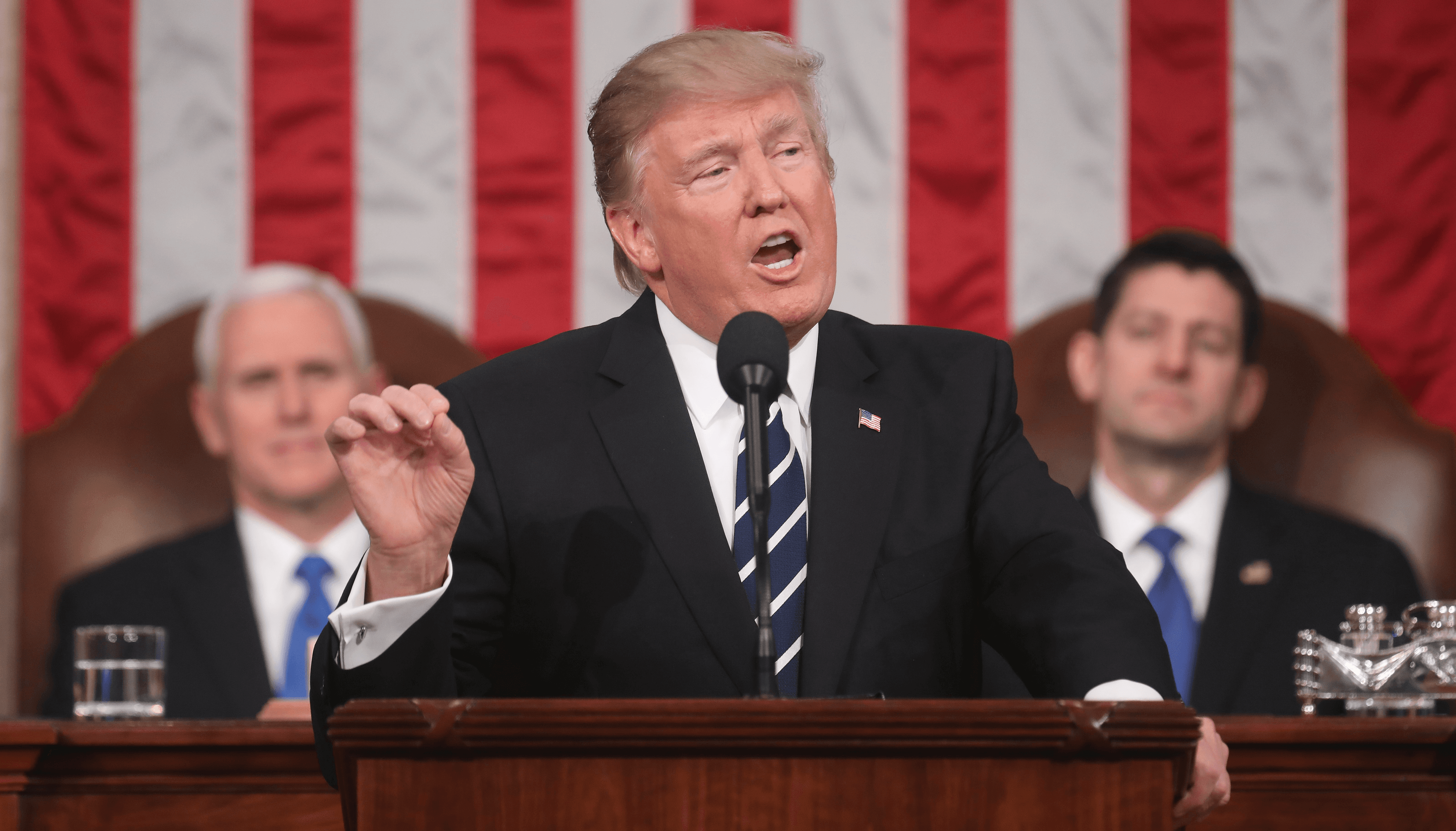The Two Trumps
In a relatively staid address to Congress, the president tried out a calmer approach. But he hasn’t changed his vision for the country.
Maybe the best way to think about Donald Trump’s speech to a joint session of Congress on Tuesday night is to think of its two audiences. There are the Republicans who basically control the entire government. And there are the folks at home. Tuesday’s speech was written to tousle the hair of the former and reassure the latter that Trump’s month-old presidency hasn’t slid into a magma pit.
Stylistically, Trump has never been sweeter. He didn’t deliver a blood-and-guts speech like he did at the Republican National Convention or his inauguration. He read from a teleprompter and (for him) used few ad-libs. As Jake Tapper noted on CNN, Trump wore a blue tie rather than his typical fiery red.
Trump tried to clean up (as they say in Washington) a lot of horrendous public statements. On Tuesday morning, he apparently wondered aloud whether recent attacks on Jewish community centers were actually “false flag” operations. The White House was slow to forcefully speak out about the shooting of two Indian men, one of whom died, in Kansas in what might have been a hate crime. In the speech, Trump mentioned both crimes and condemned “hate and evil in all its forms.”
Trump said his speech would be a “message of unity of strength, and it is a message deeply delivered from my heart.” He also talked a lot about America’s 250th birthday, which is odd, since it will occur after the expiration of what would be Trump’s second term.
You find this fluff in lots of Washington speeches. The only surprise is that it’s so un-Trumpian. As we’ve seen, Trump has a commitment less to ideology than to style. He may waver on immigration, but he will always blame somebody else for failure. Whether it’s his low approval ratings or shaky progress over the past month, Tuesday he seemed to limit the influences of his two Stephens, Miller and Bannon.
The nice paragraphs were written for Americans watching television with one eye. The policy parts of the speech weren’t unifying at all. Trump began by offering an “update” on all the things he said he’d accomplished in 30 days. He bragged about deporting people (“bad ones are going out as I speak”), and withdrawing from the Trans-Pacific Partnership. He said he “begun to drain the swamp,” prompting some laughs from the Democrats seated to Trump’s right.
Trump’s new national security adviser, H.R. McMaster, cautioned him not to use the phrase “radical Islamic terrorism” — which McMaster and a lot of people think is useless and inflammatory. Trump not only used the phrase, but accentuated every word with his right hand.
On policy, it was often hard to understand exactly what Trump wanted. He held out the possibility of “immigration reform.” This is one of those phrases that means different things to different people, and Trump gave little guidance on what his version might entail. (He called for respect for the law and protection of American wages.) He was equally gauzy on health care. He asked Congress to repeal and replace Obamacare and called for an end to the mandate that everyone buy insurance. But also called for lower drug prices and protection for people with pre-existing conditions — the latter being one of those things that most people think is achievable only with a mandate.
Trump had one emotional set piece that was equally confusing. On January 29, a raid was carried out in Yemen. One Navy SEAL, Senior Chief Petty Officer William Ryan Owens, died. A lot of people questioned whether the raid was a good idea. Owens’s father refused to meet with Trump and demanded an investigation. In an interview that aired Tuesday on Fox, Trump seemed to blame the raid on “the generals.” “They lost Ryan,” he said.
At the speech, Owens’s widow, Carryn, was seated in the presidential box at Ivanka Trump’s right. The raid, Trump now said, quoting James Mattis, was “highly successful.” “Ryan’s legacy is etched into eternity,” he added. Carryn clutched her hands, wept, and stared upward.
The mention of Owens got the night’s longest ovation as tears poured down Carryn’s cheeks. Trump said — here was the rare ad-lib — “Ryan is looking down right now, and he’s very happy, because I think he just broke a record.” Only Trump would find a way to convert a scene like that into “winning.”
Trump offered some small, revelatory moments. After praising NATO (a line that drew a rare standing ovation from the Democrats), Trump said, “My job is not to represent the world. My job is to represent the United States of America.” As The New York Times’ Carl Hulse pointed out in the paper’s instant analysis, Trump is the rare president that has turned down the post of leader of the free world. It’s one of the things he has been consistent about.
Nothing Trump said Tuesday will move legislation or break the inevitable partisan deadlock. As David Axelrod said on CNN, his approval ratings might get a temporary bump. But the appearance of “nice” Trump did raise an interesting idea: that there are two Trumps, with entirely different approaches to political outreach, chugging along on parallel tracks. Come to Twitter for the red meat and television for the dessert.

